Saving Gulf Coast Shorebirds, One Beach at a Time
Kristen Vale stands on the shore of the Gulf of Mexico, toward the end of the Bolivar Peninsula, trying to solve a dilemma. Wilson's Plovers and Least Terns come to this coastal area each spring to nest and breed after spending the winter in Central and South America. But high tides and too much rain have washed away the eggs that the birds had recently laid in the sand.
Her challenge on this day: to figure out where to replace the washed-out fencing that instructs beachgoers not to trespass into the birds' nesting territory.
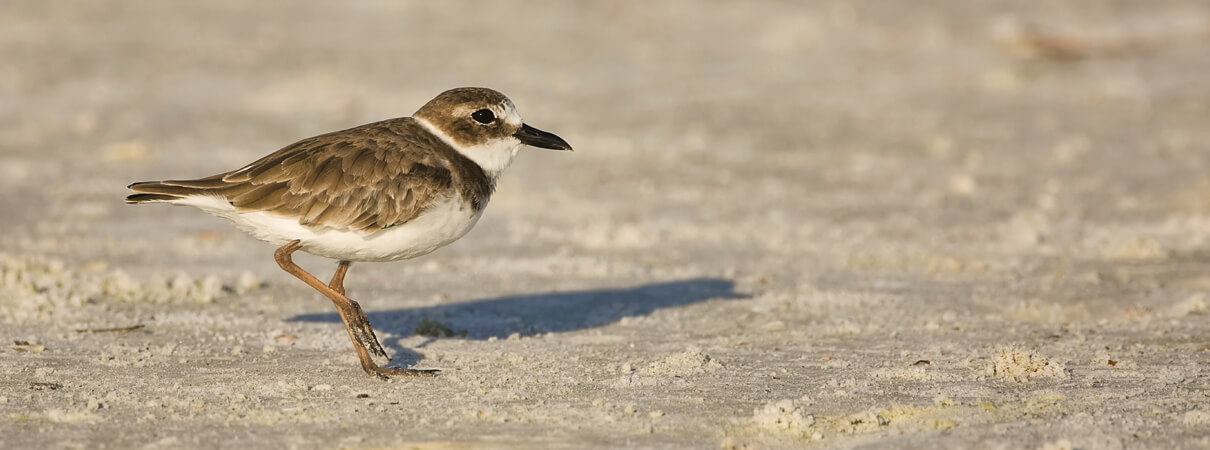
Wilson's Plovers spend the winter months in Central and South America before returning to their breeding grounds on Texas' coast. Photo by Norman Bateman/Shutterstock
Nearby, two or three Wilson's Plovers scamper about, keeping a safe distance from us and one another, watchful. One bird perches on a slight rise of sand to survey his territory like a pitcher on a mound. Acrobatic Least Terns chatter in the air, males offering females small, silvery fish in a gesture of courtship. Vale knows this behavior means the birds will lay their eggs any day now. She has to act quickly.
It's hardly a simple maneuver. She gauges tide lines, wrack lines, and the behavior of the birds. A matter of inches can determine whether the next round of eggs are protected from foot traffic and vehicles or likely to be smashed.
She settles on a spot and prepares to string the rope just below waist level, so people won't duck under. “I'm really nervous about these terns,” she says, pounding a post deep into the ground. It's happened before where Vale has replaced all of the fencing after a washout only to discover, a day or two later, that the birds had chosen spots just inches beyond the unprotected side of the fence.
If only she could tell the birds, "This side of the fence is safer. Lay your eggs here."
Sign up for ABC's eNews to learn how you can help protect birds.
Vale, who is ABC's Coastal Program Coordinator for Texas, comes here to Bolivar Flats Shorebird Sanctuary every week during the breeding season. Bolivar Flats sanctuary was established by our partner Houston Audubon. It's one of two sites on the upper Texas coast where she and a field technician collect scientific data on the birds, protect their nesting sites, and talk with beachgoers to explain how to give the birds the space they need to breed successfully.
Two fishermen approach, laden with gear, curious about what Vale is doing. She tells them she's putting up signs to protect the birds' fragile nesting areas.
“They're encroaching on my fishing!” says one of the anglers. It's hard to tell if he's serious or jesting. But Vale is firm. “Hey,” she says, polite but no-nonsense, “we have to share the beach.”
Gulf Coast Beaches: A Region in Recovery
Bolivar Flats is a spit of land right on the Gulf of Mexico. On this day in late April, two American Avocets and a Marbled Godwit pick delicately at the water's edge, in full breeding plumage. Flocks of Brown Pelicans feed on a school of fish nearby, splashing into the water by the dozens. Beyond them, large tankers and freighters crawl toward the Houston Ship Channel, a narrow body of water that separates the quiet peninsula from the city of Galveston and its crowded beaches.
Travel east along the Gulf Coast from Bolivar Flats and the scenery changes again and again. The packed brown sand of the upper Texas coast gradually gives way at the other end to beaches of gleaming white fluffy sand dunes in Alabama and Florida. The color of the water shifts, too, from a dark, murky blue-green to vibrant turquoise.
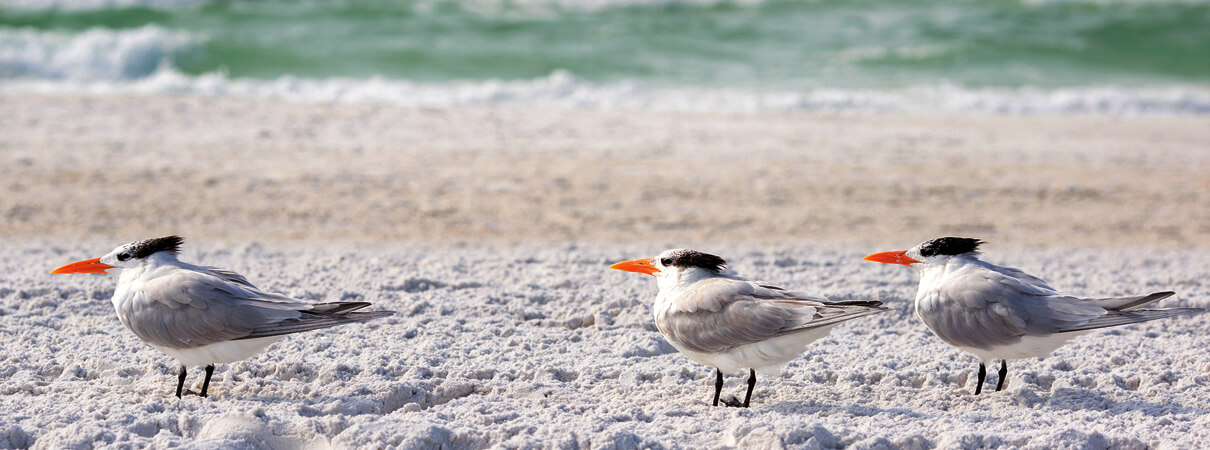
A trio of Royal Terns rest on the bright sand of a Florida Gulf Coast beach. Photo by Levrani/Shutterstock
Many of these coastal areas were devastated by the BP Deepwater Horizon oil spill in 2010. By some estimates, the millions of gallons of oil that spewed into the Gulf of Mexico killed 800,000 birds in coastal and offshore waters. But for beach-nesting birds, the cleanup efforts were disruptive at best. Vehicles, an influx of people, and heavy machinery descended on Gulf beaches in well-intentioned but chaotic masses just in time for nesting season, leading to dismal reproductive rates for these birds.
The Shorebird "Fab Four"
ABC's Gulf Conservation Program began in 2011 as a way to help these bird populations—specifically Wilson's Plover, Snowy Plover, Least Tern, and Black Skimmer—recover from the twin traumas of the oil spill and its aftermath, says Kacy Ray, ABC's Gulf Conservation Program Manager.
“We're still trying to help birds recover from this disaster, but the other main threat we address is the people threat,” Ray says. “We're trying to strike the balance between protecting habitat for the birds so they can raise their young, and still providing access to the public to enjoy the beach. It's a real fine line.”
The work got started with a grant from the National Fish and Wildlife Foundation's BP Recovered Oil Funds. As the program matured, its scope broadened. The goal to maintain or increase populations of beach-nesting birds is now threefold: protect the birds during their critical breeding season; conduct scientific monitoring to obtain valuable data on these species; and educate beachgoers and local communities on the importance of sharing the beach with the birds.

Least Terns are among the four priority species for ABC's Gulf Conservation Program, which was launched in response to the 2010 BP Deepwater Horizon oil spill. Photo by Ray Hennessy/Shutterstock
The program now includes work at 21 locations in Florida, Alabama, Louisiana, and Texas. The sites are all over the map—busy beaches, remote barrier islands, sand flats, marshes, and pristine dunes. With financial support and strategic coordination from ABC, nearly 20 partner organizations such as the U.S. Fish and Wildlife Service, Audubon Louisiana, Coastal Bend Bays and Estuaries Program, Gulf Coast Bird Observatory, and Houston Audubon carry out the work on the ground with field technicians and volunteers.
Dianne Ingram credits ABC's program with bringing some much-needed cohesion to the decentralized efforts across the region to help beach-nesting birds.
“Shorebird work is all over the place,” says Ingram, a biologist with the U.S. Fish and Wildlife Service's Alabama Field Office. “It all needs to come together into a big effort where everyone's aware and everyone's working toward the same thing.” With this gradual coordination of regional partnerships, she says, “I feel like it's starting to happen.”
Threats, from Dogs to Drivers
The birds need the help. During the summer months, people unwittingly drive over nests and chicks; trample on them; or allow unleashed dogs to root around, destroying eggs and killing chicks and adults. In more remote locations, people are less of a problem, but an imbalance of predators such as coyotes or feral hogs can wreak havoc on nesting sites. Climate change and seasonal flooding, meanwhile, add complexity nearly everywhere, affecting sea level and the severity of storms and flooding.
As a result, shorebirds are declining at a faster rate than many other species groups: The 2016 State of the Birds report indicates that migratory shorebirds are in steep decline, with a 70 percent reduction in populations since 1970. The U.S. Fish and Wildlife Service, meanwhile, considers Wilson's Plover, Snowy Plover, Least Tern, and Black Skimmer to be species of conservation concern.
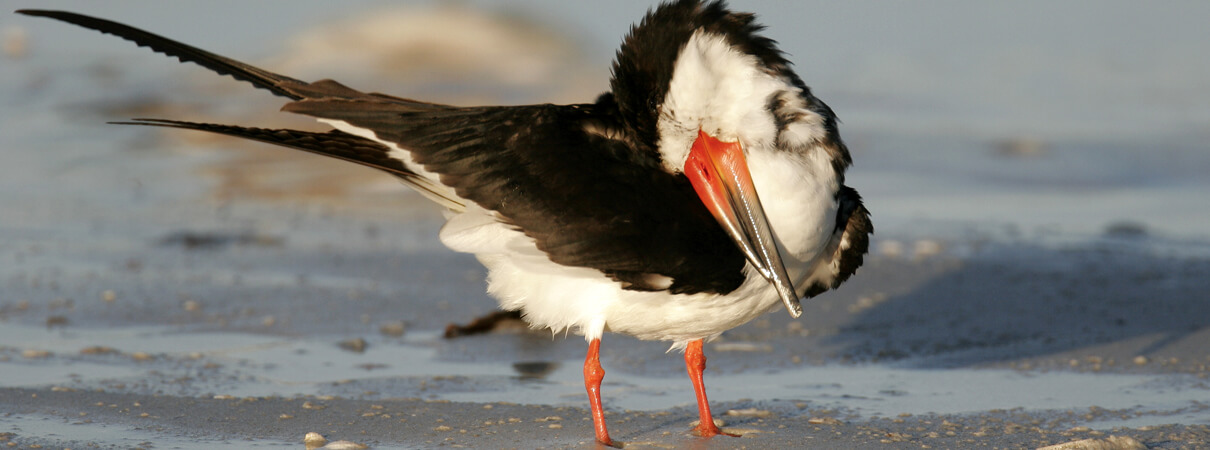
Black Skimmers use their unusual bill to catch fish while flying just inches above the surface of coastal waters. Photo by Dennis W. Donohue/Shutterstock
The program takes a similar approach at every site—scientific monitoring, nest protection, and educational outreach—but the work is very much tailored to the needs of each particular spot. On the Alabama coast, for instance, the greatest human disturbance comes not from locals who regularly frequent the same beach spots weekend after weekend, year after year. It's a tourist area, and so every week in the high season comes a new batch of out-of-town visitors—some of whom have never been to the beach before. The education process often starts afresh with every conversation.
"Conservation is About People"
“Conservation is 80 percent about people,” says Susan Heath, an Avian Conservation Biologist with Gulf Coast Bird Observatory, who with ABC support has been monitoring two sites on the Texas coast where Wilson's Plovers nest in relatively strong numbers. “So if we can't educate the public about what the birds need, it's just so much more difficult to get the job done.”
Ray says her goal as the program's manager—she regularly travels from her home office in Florida to the opposite end of the Gulf and back again, making stops at all the sites along the way—is to foster a sense of agility that matches the tremendous variability that coastal ecosystems experience from one year to the next.
“We have to be dynamic like the coast is dynamic,” she says. “We've got to be ready for a rainy season, or for an influx of predators. We've got to be ready on holidays to be out in numbers so we can educate people and protect the birds. We have to expect the unexpected.”
Signs of Recovery in Some Shorebird Populations
The Louisiana coast is one of the program's most isolated stretches of habitat. This remoteness meant that for years, data was scarce on the birds that needed it most, says Erik Johnson, Director of Bird Conservation with Audubon Louisiana. “There are a lot of barrier islands out there, far away from the universities in Baton Rouge and New Orleans,” he says. “There was nobody really working on these birds.”
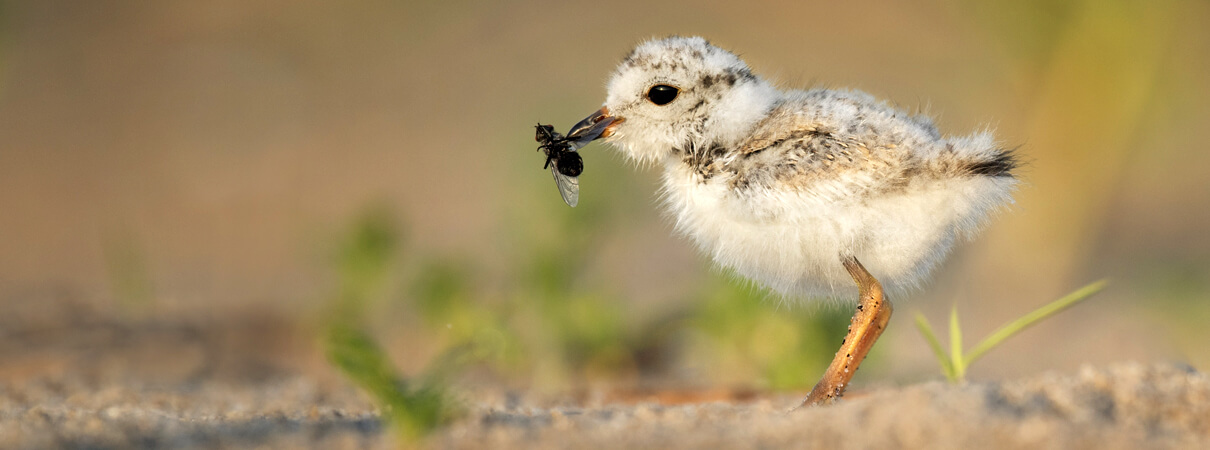
Piping Plovers spend their winters along the Gulf Coast, as well as the South Atlantic and Caribbean coasts. They migrate north each spring to nest and raise their young. Photo by Ray Hennessy/Shutterstock
This year, with support from ABC, Johnson and a team of three seasonal biologists are monitoring about 50 miles of beachfront in four parishes. Together, the 50 miles of beach encompass about 15 percent of the state population of Least Tern and Wilson's Plover, he says. Meanwhile, over the course of the past five field seasons of collaborating with ABC, the Wilson's Plover population on Grand Isle—Louisiana's only inhabited barrier island—has tripled, up to about 18 to 20 pairs from just five or six.
The consistent monitoring is beginning to pay off. “We're just now starting to get an idea of what the primary threats to populations are and where these threats are most severe,” Johnson says. “We can really start to focus conservation efforts on the sites and the concentrations of birds that need it most.”
Crazy Times and Flooding
Six hundred miles away, in Corpus Christi, Texas, David Newstead has reached a similar conclusion. Newstead, who is the Director of the Coastal Bird Program at Coastal Bend Bays & Estuaries Program, Inc., has been collaborating with ABC since 2012.
The partnership with ABC, he says, has enabled Coastal Bend Bays and Estuaries to communicate more persuasively to landowners and managers about the need for protective measures for the birds. “We've got data now that we can rely on and point to, and we can make people understand that these sites need to be protected,” he says.
Data is becoming increasingly valuable in informing conservation work, Newstead says. During a year like this one, with “crazy” tides and flooding, for instance, data helps to quantify what biologists might already expect—that birds won't be raising as many chicks. In years to come, still more data will allow conservationists to consider other key variables such as climate change and sea level rise, he says.
“We'll be able to incorporate these data and see if the birds will have a place to go.”
"Storms Create, Storms Destroy"
Across the channel from Bolivar Flats is Galveston's sprawling East Beach. This is Vale's third season working at the popular recreational site. Wilson's Plovers nest on the beach and in the dunes, and in early spring Black Skimmers often congregate in the middle of a giant sand parking lot.
It used to be that Vale would arrive and wonder, Who's going to cut the strings of the fencing? Who's going to be doing donuts around the signs? But this year, hardly anybody trespasses. “It's been this beautiful transition where people are finally starting to catch on,” she says.
Still, Vale prefers the tranquility of Bolivar Flats. Quiet, with few people and plenty of space, she imagines it to be an earthy paradise for the birds. But even here the conditions are unpredictable.
The shoreline changes with every storm. In some areas, this actually creates better habitat for the nesting birds, as shifting waters deposit sand and sediment in new places. And then, of course, there are the beachgoers. Every week Vale must weigh the needs of people—“all beaches are open to the public, and we have to respect this,” she says—and birds.
And so on this day early in the season, Vale works her way down the beach, finishing up the fencing as the terns and plovers supervise. We walk about a half-mile to the very end of the beach. This is new habitat created by the recent storm surge. Sand has washed over the beach grasses, creating ideal nesting spots.
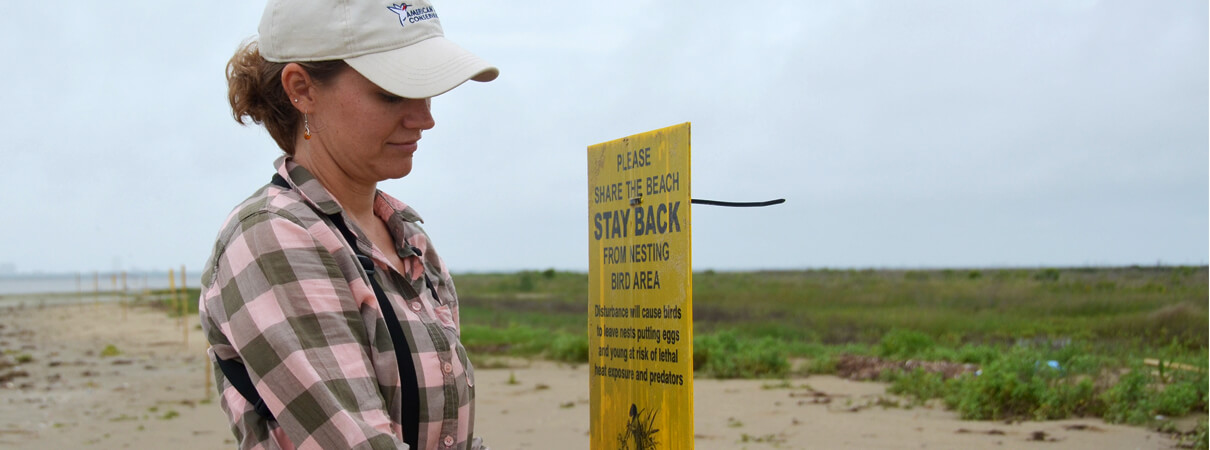
Kristen Vale, ABC's Coastal Program Coordinator for Texas, sets up a sign at the Bolivar Flats Shorebird Sanctuary in Texas. Photo by Libby Sander
“Storms create, storms destroy,” Vale says. “We just have to balance the natural disturbance with the human disturbance.” There will surely be more storms, more flooding, and more unforeseen challenges. But this storm, she says, was a blessing in disguise: at least no chicks had hatched yet.
Least Terns are still darting and flirting over our heads. The sun peeks out for a few brief moments behind rain clouds building in the west, turning the Gulf into a shimmering ribbon of gently lapping waves. Vale continues pounding the stakes into the sand.
“I'm looking at all these Least Terns and I'm so happy,” she says. “This is a good spot for them.”
(Editor's Note: Learn more about ABC's Gulf Coast program and how you can help: www.helpgulfbirds.org.)
With your support, we can better protect the places that Gulf Coast shorebirds and other migratory birds need to survive. Click here to donate.

Libby Sander is Senior Writer and Editor at American Bird Conservancy. She spent 13 years as a journalist before coming to ABC, writing news stories and award-winning features for The New York Times, the Washington Post, and The Chronicle of Higher Education. You can follow her on Twitter at @libsander.


















































